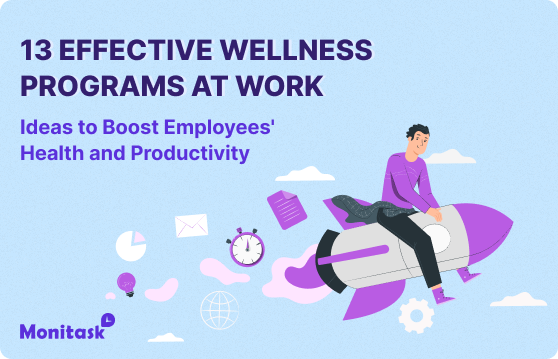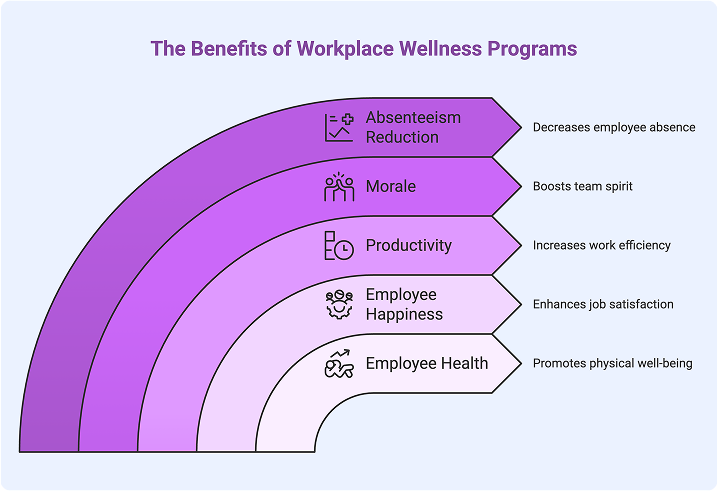13 Effective Wellness Programs at Work: Ideas to Boost Employees’ Health and Productivity

Employee wellness is no longer a luxury—it’s a necessity.
A well-designed wellness program can significantly enhance employees’ health, morale, and productivity while reducing absenteeism and healthcare costs.
But implementing an effective wellness program requires thoughtful planning and creativity.
13 Workplace Wellness Program Ideas
Creating a culture of wellness in the workplace requires a combination of physical, mental, and emotional support initiatives.
These wellness programs can be tailored to fit various workplace environments, ensuring that employees feel supported and motivated to adopt healthier lifestyles.
Here are 13 effective wellness program ideas that can help improve employee well-being and performance at work.
1. Fitness Challenges
Encourage employees to participate in step challenges, cycling contests, or virtual workout competitions to stay active and engaged. Fitness challenges can be structured in different ways to cater to all fitness levels. For example:
- Step Count Challenges – Employees track their daily steps, competing individually or in teams to reach a set goal.
- Virtual Race Events – Employees log their running or cycling miles over a specific period.
- Workout Bingo – A fun and interactive challenge where employees complete various exercises to form a winning pattern on a bingo card.
- Office Workout Breaks – Encourage short fitness breaks throughout the workday to keep energy levels high.
- Leaderboards and Rewards – Create a friendly competition with incentives like gift cards, wellness perks, or recognition awards for top performers.
Fitness challenges promote physical activity, teamwork, and a positive work environment, making them a great addition to any workplace wellness program.
2. On-Site or Virtual Yoga and Meditation
Incorporating yoga and meditation into the workplace can significantly benefit employee well-being by reducing stress, enhancing focus, and improving posture. Companies can facilitate this by offering weekly on-site yoga classes led by a professional instructor and providing virtual sessions for remote workers. They can encourage mindfulness breaks for simple breathing exercises, create lunchtime meditation groups for relaxation, and offer subscriptions to meditation apps like Headspace or Calm. Additionally, offering chair yoga routines tailored for desk workers can help relieve tension without requiring special equipment, promoting a healthier work environment overall.
By integrating yoga and meditation into the work routine, companies can create a more relaxed, focused, and resilient workforce while promoting a positive company culture.

3. Healthy Snack and Meal Options
Providing access to nutritious food can significantly boost employee energy levels, cognitive function, and overall well-being. Encouraging healthy eating habits in the workplace can help reduce fatigue, improve focus, and decrease the risk of chronic illnesses. Here are several ways companies can integrate healthy food options into their wellness programs:
- Stock Break Rooms with Nutritious Snacks: Replace vending machines filled with processed snacks with healthier alternatives such as fresh fruits, vegetables, nuts, granola bars, yogurt, and whole-grain crackers.
- Subsidized Healthy Meal Options: Offer discounts on nutritious meals at the cafeteria or through meal delivery services to encourage better eating habits.
- On-Site Nutritionist Consultations: Bring in dietitians to provide personalized meal planning and dietary advice to employees. Employees can learn how to make better food choices based on their health goals.
- Healthy Cooking Demonstrations: Host live or virtual cooking workshops where employees can learn to prepare quick, nutritious meals at home or work.
- Company-Sponsored Farmers’ Markets: Partner with local farms to provide employees with fresh produce at discounted prices or set up an on-site farmers’ market for easy access to healthy food options.
- Smoothie and Juice Bars: Offer smoothie stations or juice bars in the office, allowing employees to choose fresh, nutrient-dense beverages instead of sugary soft drinks.
- Healthy Potluck Events: Encourage employees to participate in healthy potlucks, where they can share nutritious homemade dishes and discover new healthy recipes.
- Nutritional Education Programs: Provide workshops, newsletters, or digital resources about balanced eating, portion control, and meal prep strategies.
- Label Nutritional Information: Clearly display nutritional content on cafeteria and vending machine items to promote informed choices and healthy eating habits.
- Mindful Eating Spaces: Designate quiet, comfortable areas where employees can enjoy their meals without distractions, promoting mindful eating practices.
By integrating these initiatives, companies can foster a workplace environment that prioritizes healthy eating habits, leading to increased employee engagement, productivity, and overall wellness.
4. Mental Health Support Programs
Mental health is just as important as physical health. Employers can support employees by offering access to professional counseling services, either in-house or virtually, to help with stress, anxiety, and personal challenges. Organizing mental health awareness campaigns, stress-reduction activities, and mindfulness initiatives can help create a more supportive work culture. Providing free access to mental health apps and flexible work options can further enhance employee well-being.

5. Ergonomic Workstations
A comfortable workspace reduces the risk of injury and improves productivity. Employers can:
- Provide Adjustable Desks and Chairs: Ensure that employees have access to ergonomic furniture that supports posture and comfort.
- Standing Desk Options: Offer sit-stand desks to encourage movement throughout the day.
- Ergonomic Assessments: Conduct individual workstation evaluations to identify improvements for employee comfort.
- Posture Training Workshops: Educate employees on proper posture, stretches, and exercises to prevent workplace injuries.
- Screen Time Management Tools: Introduce blue light filters and screen break reminders to reduce eye strain and fatigue.
6. Wellness Days or Paid Time Off for Health
Giving employees time to focus on their well-being can boost morale and prevent burnout. Companies can:
- Implement Wellness Days: Designate specific days where employees can take time off for self-care and relaxation.
- Paid Health Checkups: Offer additional leave or financial support for preventive health screenings and medical checkups.
- Encourage Mental Health Breaks: Normalize taking short breaks throughout the day to reduce stress and recharge.
- Wellness Retreats: Organize off-site wellness retreats where employees can participate in fitness, meditation, and team-building activities.
7. Employee Assistance Programs (EAPs)
EAPs provide confidential support for employees dealing with personal or work-related challenges. These programs typically include counseling services for mental health, financial, and legal issues, as well as work-life balance resources such as childcare and eldercare assistance. Crisis intervention services and educational workshops on stress management, career growth, and wellness can also be part of an effective EAP.
Maximize productivity of your business
Track employee productivity and simplify work with them
8. Standing Meetings
Standing meetings are a great way to break away from the sedentary nature of traditional office meetings. By encouraging employees to stand or even walk during meetings, you promote better posture, energy levels, and focus. Standing increases blood circulation and reduces the physical strain that comes from sitting for prolonged periods. Walking meetings, in particular, can foster creativity, improve communication, and help participants feel more energized. This practice can be especially beneficial for those who spend most of their day at a desk or in front of a screen.
9. Flexible Work Hours and Remote Work Options
Offering flexible work hours and remote work options can greatly enhance employee work-life balance. Employees who have the flexibility to manage their schedules can reduce stress, increase productivity, and maintain better overall well-being. Companies can implement hybrid work policies, allow for occasional remote work days, and provide necessary tools to support virtual collaboration.
By implementing these wellness initiatives, companies can create a healthier, more engaged workforce, leading to increased productivity and job satisfaction.

10. Wellness Webinars and Education Sessions
Hosting wellness webinars and educational sessions is an effective way to equip employees with the tools they need to improve their health. You can invite experts in nutrition, fitness, mental health, and overall well-being to share advice and strategies for managing stress, maintaining a healthy diet, and staying active. These sessions can be offered regularly to ensure employees are consistently receiving valuable knowledge that supports both their personal and professional development. They may also be recorded and made available for later viewing, allowing employees to access them at their convenience.

11. Incentives for Healthy Behaviors
Incentivizing healthy behaviors helps motivate employees to prioritize their health. Examples of incentives could include:
- Gift cards: For those who meet certain health goals or participate in wellness programs.
- Extra PTO: Rewarding employees who consistently engage in wellness activities, like daily exercise or attending wellness webinars.
- Company-branded merchandise: T-shirts, water bottles, or fitness gear to promote wellness.
- Discounted gym memberships: Offering deals with local fitness centers or online workout platforms.
- Health insurance discounts: Providing incentives like reduced premiums for employees who engage in healthy habits.
12. Smoking Cessation Programs
Smoking cessation programs are critical for supporting employees who are trying to quit smoking. These programs can include counseling, nicotine replacement therapy, or access to support groups. Offering incentives like reduced health insurance premiums for those who successfully quit or providing access to resources such as apps or professional guidance can make a significant difference in helping employees succeed. Not only does this contribute to the overall health of employees, but it can also lower healthcare costs for the company and improve workplace morale.
13. Wellness Challenges and Rewards
Create fun wellness challenges with rewards for participation, such as team steps challenges or mindfulness streaks.

Conclusion
Implementing wellness programs at work can lead to healthier, happier, and more productive employees.
By prioritizing employee well-being, companies can enhance workplace morale, reduce absenteeism, and boost overall performance.
Whether it’s fitness challenges, mental health support, or ergonomic workspaces, investing in wellness programs is a win-win for both employers and employees.
– The Monitask Team
Frequently Asked Questions
How do wellness programs benefit employees?
Wellness programs help employees stay healthy, reduce stress, improve focus, and increase job satisfaction.
What is the best wellness program for a small business?
Small businesses can start with affordable initiatives like hydration stations, standing meetings, and wellness webinars.
How can companies encourage participation in wellness programs?
Companies can offer incentives, make programs fun and engaging, and integrate wellness into the company culture.
Are wellness programs expensive to implement?
Not necessarily. Many wellness programs, such as flexible work hours, standing meetings, and wellness challenges, are low-cost yet highly effective.



